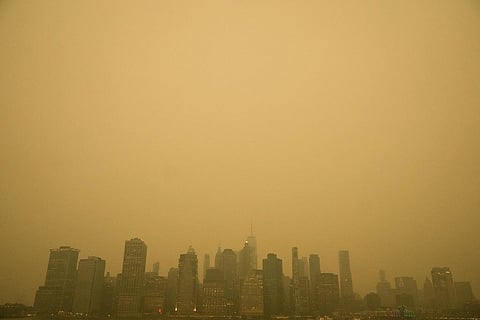

On June 7, 2023, IQAir Index ranked New York City the worst in terms of air quality. A thick orange haze has engulfed the city, forcing schools to call off outdoor extracurricular activities.
As the threatening cloud hovered over the city, local authorities recommended that people stay indoors as much as possible. Due to poor visibility, the Federal Aviation Administration even ordered a ground stop for all flights departing from LaGuardia Airport. There are concerns that the Northeastern United States will continue to experience air pollution in the coming days.
The dystopian orange skies are due to the flames that have been raging north of the US-Canada border — which is hundreds of kilometres away from New York City. Wildfires have been burning Canada’s forests for several weeks, and the country has witnessed over 400 fire events so far, according to authorities.
New York City Mayor Eric Adams responded to the situation, saying the current poor air quality is an “urgent reminder” to take action on climate change.
The size and intensity of wildfires have seen an increase in past decades. Some recent occurrences show how wildfires are spreading to previously uncharted territory — even to regions in the Arctic.
Fire activity has changed, with more destructive flames erupting more frequently in fire-prone regions like Siberia, California and Australia. On the other hand, in regions with pyro-dependent habitats, such as the grasslands of North America and Brazil, fires appear to be reducing.
Countries, including the US, Brazil, Australia and Indonesia, have established forest administration agencies and passed forest preservation laws to lessen the effects of wildfires.
Greece is the first country in the world to have established a Climate Crisis Ministry to address the issues that the planet’s changing climate presents. As said by Christos Styliandes, the minister for Climate Crisis, disaster prevention and preparedness are “the most effective weapon.”
Changes in fire activity patterns and an increase in the frequency of wildfires are mostly caused by climate change. Increased incidents can be attributed to changing landscapes and poor management of forests.
Global warming, which dries out plants and soil and increases the amount of flammable debris, is a significant contributing element. Forests are becoming less robust due to the ongoing climate change, which increases their susceptibility to flames.
In 2020, Verkhoyansk — a town in Siberia — recorded a temperature of 38 degrees Celsius — the highest temperature ever recorded in the Arctic region. During this time, most of the Arctic region, especially Siberia, experienced an unprecedented heatwave, with temperatures in the Siberian Arctic climbing up to 10°C above normal.
This contributed to forest fires and a significant sea ice loss, making 2020 one of the three hottest years ever recorded despite a cooling La Nina event at the end of the year.
Another event is the horrific 2019-2020 Australian bushfire — known as the ‘Black Summer’ — that burnt more than 46 million acres of land. More than a billion mammals, birds and reptiles across eastern Australia are estimated to be affected by the fire catastrophe, The Conversation reported.
Its impact on animals other than koalas — a species native to Australia that became the face of the bushfires — was much more, reported Down To Earth. Several reptiles, including skinks, which live in densities of more than 1,500 individuals per hectare, were affected.
In California, about 14,000 lightning strikes in 2020 contributed to roughly 900 blazes to burn through 1.5 million acres of land. Those who lived far from the site were also affected by it. While particulate pollution in California increased due to the smoke from the fires, poor air quality reached dangerous levels in numerous locations.
In fact, wildfires release more carbon dioxide into the sky, creating a vicious cycle. The number of wildfires worldwide is expected to double by 2100 and spread to areas that have never seen one before, according to a UN assessment released in February 2022.
More resources must be directed towards avoiding wildfires rather than putting them out after they have done enormous damage. Though it is difficult to completely stop wildfires from occurring, reducing climate change will be essential for reducing their damaging effects.